

Case Report - Year 2023 - Volume 38 - Issue 3
Bilateral V-Y medial fasciocutaneous thigh flap in perineal reconstruction for hidradenitis suppurativa: Case report
Retalho fasciocutâneo medial da coxa em V-Y bilateral na reconstrução perineal por hidradenite supurativa: Relato de caso
ABSTRACT
Introduction: Hidradenitis suppurativa (HS) is a chronic inflammatory disease that preferentially affects the intertriginous skin and is associated with numerous systemic comorbidities. The perineal area is the second most commonly affected area after the armpit. Wide excision is the treatment most likely to achieve better results with a lower risk of recurrence. With extensive surgical excision, flap closure offers a greater likelihood of definitive treatment. Some flaps have been described to reconstruct defects in the perineal region after cancer, but few have been studied in treating HS.
Case Report: A 43-year-old woman with perineal HS underwent resection of the lesions and reconstruction with a bilateral V-Y medial thigh fasciocutaneous flap to treat the disease. The flap allowed complete closure of the total perineum without serious complications.
Conclusion: This case shows that it is useful and practical to use the V-Y medial thigh fasciocutaneous flap for perineal reconstruction after wide resections of skin, apocrine glands, and hair follicles in the treatment of HS, offering good skin coverage and subcutaneous cellular tissue with supply reliable vascular flap, which avoids sequelae associated with muscle sacrifice and reaches larger dimensions than other flaps, and can be considered in selected cases as an alternative in the surgical treatment of perineal HS.
Keywords: Surgical flaps; Hidradenitis suppurativa; Perineum; Hidradenitis; Perforator flap.
RESUMO
Introdução: A hidradenite supurativa (HS) é uma doença inflamatória crônica que afeta
preferencialmente a pele intertriginosa e está associada a numerosas
comorbidades sistêmicas. A área perineal é a segunda área mais comumente
afetada depois da axila. A excisão ampla é o tratamento que tem maior
probabilidade de atingir melhores resultados com menor risco de recorrência.
Com a excisão cirúrgica extensa, o fechamento com retalho oferece maior
probabilidade de tratamento definitivo. Alguns retalhos são descritos para
reconstruir defeitos da região perineal após câncer, porém poucos deles são
estudados no tratamento da HS. Relato de Caso: Mulher de 43 anos, com HS
perineal, submetida a ressecção das lesões e reconstrução com retalho
fasciocutâneo medial da coxa em V-Y bilateral como tratamento da doença. O
retalho permitiu o fechamento completo do períneo total sem complicações
graves.
Conclusão: Este caso mostra que é útil e prático utilizar o retalho fasciocutâneo medial
da coxa em V-Y para reconstrução perineal após ressecções amplas de pele,
glândulas apócrinas e folículos pilosos no tratamento da HS, oferecendo boa
cobertura de pele, e tecido celular subcutâneo com suprimento vascular
confiável, que evita sequelas associadas a sacrifício de músculos e alcança
dimensões maiores do que outros retalhos, podendo ser considerado em casos
selecionados como uma alternativa no tratamento cirúrgico da HS
perineal.
Palavras-chave: Retalhos cirúrgicos; Hidradenite supurativa; Períneo; Hidradenite; Retalho perfurante
INTRODUCTION
Hidradenitis suppurativa (HS) is a chronic, inflammatory, recurrent, and debilitating cutaneous follicular disease that usually presents after puberty with deep, inflamed, painful lesions in areas of the body with apocrine glands, most commonly axillary, inguinal, and anogenital regions, which can lead to serious physical and emotional consequences.
The prevalence of HS is unknown, but estimates range from 0.00033% to 4.10%. It occurs more frequently in young adults and is twice as common in women as men1,2. The perineal area is the second most commonly affected, treated with wide excisions, requiring challenging reconstructions. Surgical resection of affected tissues offers greater hope for definitive treatment of HS, so having a flap option to reconstruct large perineal defects after HS resections is important2.
Some techniques have already been published for reconstructing defects in the perineal and gluteal region in treating HS, such as primary closure, grafts, or perforator flaps of the superior and inferior gluteal artery. However, they have not been widely studied in extensive defects that compromise the anterior and posterior perineum2,3.
The V-Y medial thigh fasciocutaneous flap is a flap based on perforating arteries of the femoral artery, is technically reproducible and provides sufficient volume with good coverage of skin and subcutaneous cellular tissue for extensive defects of the perineum in the treatment of HS.
OBJECTIVE
To present a case report that shows the use of the medial fasciocutaneous thigh flap in bilateral V-Y advancement as an option for reconstructing extensive areas of the perineal region to treat hidradenitis suppurativa.
A female patient, 43 years old, was referred to the plastic surgery service after a diagnosis of hidradenitis suppurativa in the anterior and posterior perineum without prior treatment (Figure 1). It was planned resection of the affected tissue and reconstruction with a bilateral V-Y medial thigh fasciocutaneous flap in two surgical stages.
With the patient in the lithotomy position, under general anesthesia, lesions in the perineal region and bilateral labia majora were resected, with a margin of 1.5 cm laterally and medially, up to the subcutaneous plane, with resection of the entire lesion (Figure 2), collection of samples for anatomopathological study, cultures using negative pressure therapy at 125mmHg continuous. The anatomopathological report concluded a diagnosis of bilateral hidradenitis suppurativa, and culture results indicated infection with multisensitive Staphylococcus aureus and Corynebacterium striatum, with antibiotic therapy being indicated.
After 48 hours, the defect was reconstructed with 25x30cm flaps on the right thigh and 25x22cm on the left thigh, based on perforating arteries of the femoral artery. The dissection was performed in the fasciocutaneous plane up to the fascial plane with detachment of the proximal and distal third of the flap and advancement in V-Y, with fixation points and placement of portovac drains with distal exteriorization and closure in layers (Figure 3).
The procedure was carried out uneventfully; the flaps had good skin and subcutaneous cellular tissue coverage, and no medications were prescribed to reduce the number of bowel movements or an ostomy. Twenty-four hours after surgery, antithrombotic prophylaxis was prescribed and maintained for 7 days. On the second postoperative day, she was allowed to sit and walk with short steps and was discharged on the sixth day. The drains were removed on the eighth day. Two months after surgery, three areas of dehiscence were observed and treated conservatively. One and a half years after surgery, the flap remains in good condition, with no evidence of disease recurrence or vulvar irritation, with an acceptable aesthetic result (Figures 4 to 6).
DISCUSSION
Hidradenitis suppurativa (HS) is a chronic, inflammatory, recurrent, debilitating, and cutaneous disease characterized by painful, deep and inflamed lesions, mainly in the regions containing apocrine glands and hair follicles, characterized by a perifollicular leukocyte infiltrate. The prevalence of HS varies from 1% to 4% in Europe and the United States in the general population. It generally manifests after puberty in the second and third decades of life, with a female predominance. Long-term lesions can be complicated by squamous cell carcinoma1-3.
Hurley staging is recommended in the clinical setting as it is simple and helps determine therapeutic needs. Hurley stage I is characterized by the presence of single or multiple abscesses, however, without fistula or scars; stage II is due to the presence of single or multiple recurrent abscesses, separated by the formation of fistulas and scars; and stage III is characterized by the presence of multiple interconnected fistulas and abscesses involving at least one complete anatomical area. For stage III, the preferred treatment is wide surgical resections of the skin, apocrine glands, and hair follicles because they are more likely to be cured, with a lower recurrence rate of HS2-4. For this reason, having flap options to reconstruct defects after large HS resections in the perineal region is essential.
Perineal wounds that close primarily are associated with a high recurrence rate of HS3. Despite being a resolving option, healing by secondary intention, even in large excisions, subjects patients to long periods of painful dressing changes, with pronounced scar contraction and an unpleasant final appearance2,3. Closure with a partial skin graft is also described, but in the perineal region, the risk of loss due to bacterial contamination is high3-5.
Some flaps based on the descending and medial branches of the inferior gluteal and deep femoral arteries have been published in the reconstruction of HS wounds of the perineum partially, but none of them have been described for reconstructing large wounds that compromise the total perineum4,6.
With pedicled gluteal flaps based on superior and inferior gluteal artery perforators, studied in the reconstruction of perineal defects due to HS, despite being considered large flaps, a skin dissection of 10 to 12 cm was necessary to reach more distant areas, making flaps more difficult to create, in contrast to the fasciocutaneous tissue of the thigh. Furthermore, due to the proximity to the perianal region, in some cases antidiarrheal medications or colostomy were indicated to inhibit fecal contamination of the reconstructed areas with a minimum hospitalization time of 6 days4,5,7.
Gluteal flaps generally require a prone position postoperatively, which is more uncomfortable for the patient. Other flaps, such as the fasciocutaneous lotus petal and gluteal fold flaps, have been described for perineal wounds caused by HS, but they have been indicated for defects in the medial and posterior zone of the perineum, and in the case of the total perineum, they have not been described so far5,6,8.
The V-Y medial thigh fasciocutaneous flap is a flap based on femoral artery perforators; it has been widely studied in perineal defects caused by cancer and not for HS, despite multiple advantages such as covering defects in the anterior and posterior perineum without requiring pedicle dissection, making it a flap that is easier and more practical to make9,10. This flap does not sacrifice muscle, avoiding donor site morbidity, and the vascular supply is reliable.
The medial fasciocutaneous flap of the thigh in V-Y advancement is a reproducible technique, offers sufficient coverage of skin and subcutaneous cellular tissue, being a good option for reconstructing defects after wide resections of skin, apocrine glands, and hair follicles in the treatment of severe perineal HS, with acceptable aesthetic and functional results.
REFERENCES
1. Goldburg SR, Strober BE, Payette MJ. Hidradenitis suppurativa: Epidemiology, clinical presentation, and pathogenesis. J Am Acad Dermatol. 2020;82(5):1045-58. DOI: 10.1016/j.jaad.2019.08.090
2. Mughal M, Baker RJ, Muneer A, Mosahebi A. Reconstruction of perineal defects. Ann R Coll Surg Engl. 2013;95(8):539-44. DOI: 10.1308/003588413x13629960047155
3. Skorochod R, Margulis A, Adler N. Surgical Management of Hidradenitis Suppurativa: Factors Associated with Postoperative Complications and Disease Recurrence. Plast Reconstr Surg Glob Open. 2023;11(1):e4752. DOI: 10.1097/GOX.0000000000004752
4. Unal C, Yirmibesoglu OA, Ozdemir J, Hasdemir M. Superior and inferior gluteal artery perforator flaps in reconstruction of gluteal and perianal/perineal hidradenitis suppurativa lesions. Microsurgery. 2011;31(7):539-44. DOI: 10.1002/micr.20918
5. Kishi K, Nakajima H, Imanishi N. Reconstruction of skin defects after resection of severe gluteal hidradenitis suppurativa with fasciocutaneous flaps. J Plast Reconstr Aesthet Surg. 2009;62(6):800-5. DOI: 10.1016/j.bjps.2007.09.063
6. Argenta PA, Lindsay R, Aldridge RB, Siddiqui N, Burton K, Telfer JR. Vulvar reconstruction using the “lotus petal” fascio-cutaneous flap. Gynecol Oncol. 2013;131(3):726-9. DOI: 10.1016/j.ygyno.2013.08.030
7. Saunte DML, Jemec GBE. Hidradenitis Suppurativa: Advances in Diagnosis and Treatment. JAMA. 2017;318(20):2019-32. DOI: 10.1001/jama.2017.16691
8. Sugio Y, Tomita K, Hosokawa K. Reconstruction after Excision of Hidradenitis Suppurativa: Are Skin Grafts Better than Flaps? Plast Reconstr Surg Glob Open. 2016;4(11):e1128. DOI: 10.1097/GOX.0000000000001128
9. Wong DS. Reconstruction of the perineum. Ann Plast Surg. 2014;73(Suppl 1):S74-81. DOI: 10.1097/SAP.0000000000000237
10. Saito A, Sawaizumi M, Matsumoto S, Takizawa K. Stepladder V-Y advancement medial thigh flap for the reconstruction of vulvoperineal region. J Plast Reconstr Aesthet Surg. 2009;62(7):e196-9. DOI: 10.1016/j.bjps.2009.01.090
1. Universidade de São Paulo, São Paulo, SP,
Brazil
2. Faculdade de Medicina da Universidade de São
Paulo, São Paulo, SP, Brazil
Corresponding author: Alexander Fabricio Vicente-Rivas Rua Alves Guimarães, 1554, Pinheiros, São Paulo, SP, Brazil, Zip Code: 05410-000, E-mail: afvr90@live.com
Article received: June 26, 2022.
Article accepted: August 20, 2023.
Conflicts of interest: none.



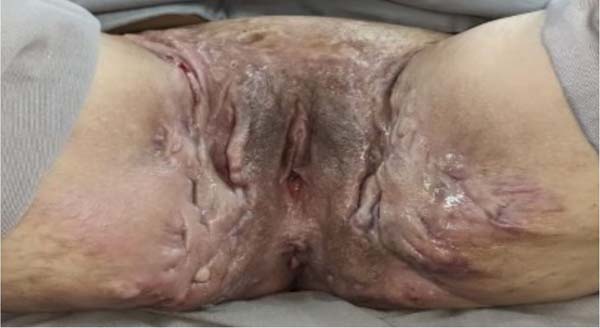

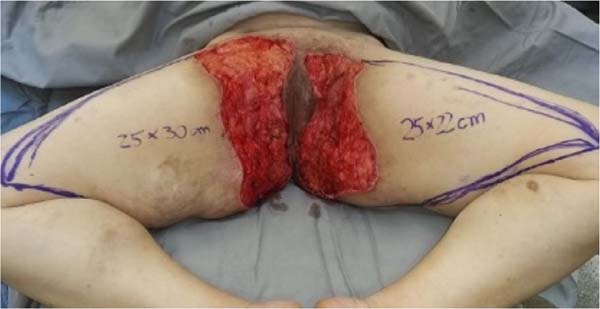

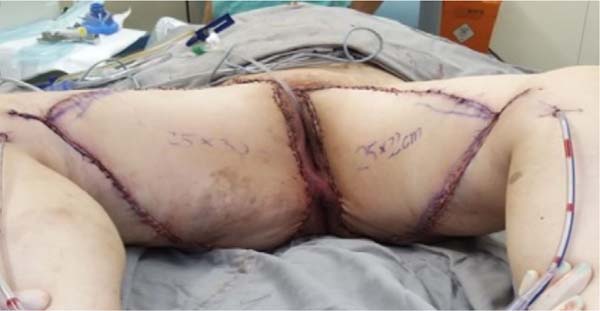

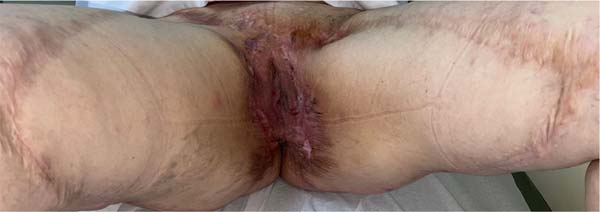

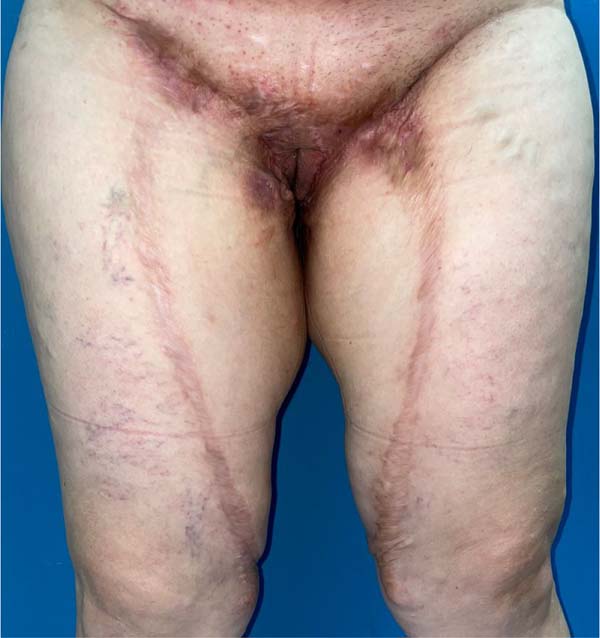

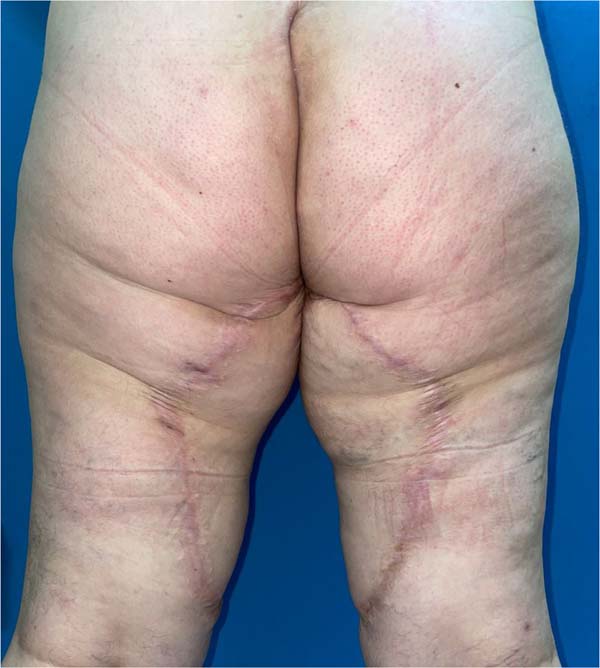

 Read in Portuguese
Read in Portuguese
 Read in English
Read in English
 PDF PT
PDF PT
 Print
Print
 Send this article by email
Send this article by email
 How to Cite
How to Cite
 Mendeley
Mendeley
 Pocket
Pocket
 Twitter
Twitter